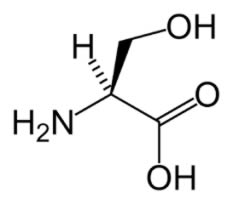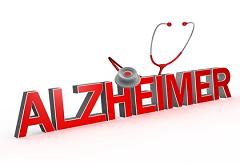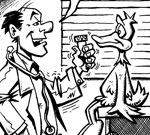What Everyone Needs to Know About Serine?
| Share on Facebook | Share on Twitter | Share on Google+ |
Serine is a nonessential amino acid that the human body can make from two other amino acids, glycine and threonine. Serine is an important component of proteins in the brain, and a compound the body makes from serine, phosphatidylserine, is an important component in the myelin sheaths that protect nerve cells from chemical and mechanical injury. Too much serine, however, can be toxic to nerve cells. The amino acids expert Dr. Eric Braverman even calls it "the potentiator of madness."
What Serine Does in the Human Body
 Serine is an extremely reactive amino acid found in the membranes lining every cell in the body. It is involved in the metabolic processes that burn glucose and fatty acids for energy. It is involved in the making of all four of the A-G-C-T bases of DNA, and it provides methyl groups involved in the methylation of DNA. This is the process through which methyl groups stick to genes and determine whether they are turned on or off. Methylation of the genes for type 2 diabetes, for instance, can cause the individual to stay thin and never develop the disease.
Serine is an extremely reactive amino acid found in the membranes lining every cell in the body. It is involved in the metabolic processes that burn glucose and fatty acids for energy. It is involved in the making of all four of the A-G-C-T bases of DNA, and it provides methyl groups involved in the methylation of DNA. This is the process through which methyl groups stick to genes and determine whether they are turned on or off. Methylation of the genes for type 2 diabetes, for instance, can cause the individual to stay thin and never develop the disease.The body uses serine to make creatine, which combines with water to "pump up" muscle mass. Serine is a component of the antibodies and immunoglobulins that fight infections, and it is a component of choline, ethanolamine, sarcosine, and phospholipids involved in the transmission of signals through the nervous system.
Serine can be converted to pyruvate, which enables the muscles and the liver to release stored glucose from glycogen. It is also the grandparent of the oxygen transport molecule hemoglobin, the compound that makes blood red and that enables it to oxygenate the whole body. Hemoglobin is made from amino-levulinic acid, which is made from glycine, which is made from serine.
The amino acid serine and the amino acid glycine are interconvertible. When the body needs serine it does not obtain from the digestion of food, it uses glycine and threonine, but it has to have enzymes made from three B vitamins, vitamin B3 (niacin), vitamin B6 (pyridoxine), and folic acid. For the brain to use serine to make the protective compound phosphatidylserine, it needs the essential amino acid methionine to "work it in" to cell membranes, and folic acid to complete the conversion. When there is not enough methionine or folic acid for the synthesis to be performed, the result, clinical observations tells us, can literally be madness.
How Much Serine Do We Need From Our Diets?
Since serine in a non-essential amino acid, there is no recommended daily intake (RDI) and there is no definition of serine deficiency. Many of the foods nutritionists never recommend, such as processed cheese, hot dogs, and luncheon meat, are actually very high in serine. This amino acid is also abundant in foods that often cause sensitivity reactions, such as gluten in wheat and the protein in soy. One nutritionist commented, "If it's a protein food and you shouldn't eat it, it's probably high in serine."
The downside to eating these foods is that they can cause allergic reactions in the brain that interfere with mental function. The more serine there is in the food, the more likely the brain reaction.
| Food | Mg Serine in 100-Gram Serving |
| Egg White | 6079 |
| Soy Protein Isolate | 4594 |
| Whole Eggs | 3523 |
| Spirulina | 2998 |
| Gelatin (Jell-O), Unsweetened | 2605 |
| Cheese Whiz | 2400 |
| Whitefish (such as used at Long John Silver's fast food restaurants) | 2340 |
| Swiss Cheese | 1640 |
| Provolone Cheese | 1450 |
| Lima Beans | 1428 |
| Bacon | 1408 |
| Turkey (Mixed White and Dark Meat) | 1198 |
| Wheat Germ | 1102 |
| Quinoa | 1101 |
| Chorizo | 993 |
| Venison | 900 |
| Avocado | 80 |
Serine Side Effects
In fact, the serine in food isn't even absorbed as serine, at least if the lining of the intestines is intact, there is enough vitamin B6 to create the enzyme that transforms serine into glycine, and serine is not consumed in huge amounts (over 15,000 mg, the equivalent of eating a 2-pound steak or a triple order of fish and chips).
And when serine is absorbed in large amounts, it causes a variety of nasty side effects, ranging from increasing tumor growth to depleting the body's supply of adrenaline to making allergies worse.
Serine injections have been known to induce catalepsy, freezing in place while still awake. There are a very few people who may benefit from taking supplemental serine under medical supervision; usually these are people who have intractable pain that can't be relieved with morphine. Taking a serine supplement is not something you want to try on your own, but supplemental phosphatidlyserine is a different matter altogether.
What Is Phosphatidylserine?
Phosphatidlyserine is a chemical the body makes serine (which it in turn makes from glycine and methionine) with the addition of a complex sugar. This chemical is found in the lining of nerve cells, especially in the hippocampus, the part of the brain that integrates memories and makes them available to consciousness. As you might imagine, the food richest in phosphatidylserine is beef brains, which are no longer consumed because of concerns about bovine spongioform encephalopathy, BSE, colloquially known as "mad cow disease."
| Food | Milligrams of Phosphatidylserine Per 100-Gram Serving |
| Anchovy | 25 |
| Atlantic cod | 28 |
| Atlantic herring | 360 |
| Atlantic mackerel | 480 |
| Beef | 69 |
| Beef brain | 713 |
| Carrot | 2 |
| Chicken breast, with skin | 85 |
| Chicken heart | 414 |
| Chicken leg, with skin, without bone | 134 |
| Chicken liver | 123 |
| Cow's Milk (whole, 3.5% fat) | 1 |
| Crayfish | 40 |
| Cuttlefish | 31 |
| Eel | 335 |
| European hake | 17 |
| European pilchard (sardine) | 16 |
| Ewe's Milk | 2 |
| Mullet | 76 |
| Offal (average value) | 305 |
| Pig's kidney | 218 |
| Pig's liver | 50 |
| Pig's spleen | 239 |
| Pork | 57 |
| Potato | 1 |
| Rice (unpolished) | 3 |
| Soft-shell clam | 87 |
| Soy lecithin | 10 to 25 |
| Trout | 14 |
| Tuna | 194 |
| Turkey breast without skin | 45 |
| Turkey leg, without skin or bone | 50 |
| Veal | 72 |
| White beans | 107 |
| 80 |
Phosphatidylserine for Alzheimer's Disease
 There are numerous studies of the use of animal-derived phosphatidylserine as a treatment for Alzheimer's disease, and most of them find that it is useful for relieving the depression that often accompanies the disease. The US Food and Drug Administration permits claims that phosphatidylserine may "reduce the risk of cognitive dysfunction" or "reduce the risk of dementia" in persons over the age of 60.
There are numerous studies of the use of animal-derived phosphatidylserine as a treatment for Alzheimer's disease, and most of them find that it is useful for relieving the depression that often accompanies the disease. The US Food and Drug Administration permits claims that phosphatidylserine may "reduce the risk of cognitive dysfunction" or "reduce the risk of dementia" in persons over the age of 60.
Phosphatidylserine for Age-Related Memory Loss
There is also evidence that animal-derived phosphatidylserine may help relieve memory loss in people as young as 40. In the most famous study, researchers gave a group of volunteers over the age of 50 a daily dose of 300 mg of phosphatidlyserine for 12 weeks. Psychological measurements showed that taking phosphatidylserine led to memory performance typical for people who were 12 years younger.
Phosphatidylserine for ADHD
The best indications are for a product that combines both phosphatidylserine and antioxidants called Flavay Plus. In one clinical trial, 25 out of 27 with ADHD showed improved behavior after taking the product for 4 months.
Phosphatidylserine for Athletic Performance
Phosphatidylserine is a frequently recommended "athletic specialty" supplement. It's most commonly used to treat insomnia in athletes who are on a fasting regimen (eat-stop-eat or a similar program) or on a very heavy exercise schedule that keeps them "edgy." A combination of phosphatidylserine supplements during the day and valerian products at night are used to lower cortisol and adrenaline levels to make sleep easier. Better sleep leads to greater production of growth hormone, and greater production of growth hormone leads to greater fitness and increased muscle mass. Not every athlete will benefit for phosphatidylserine, but those who have high levels of stress hormones will.
How Do You Take Phosphatidylserine?
Ideally, you would take an animal-derived phosphatidylserine product in a dosage of 100 mg three times a day. Soy-based phosphatidylserine sometimes does not get the same good results as animal-derived phosphatidylserine; of course, if you are a vegan or vegetarian, you would prefer soy. For athletes, phosphatidylserine and valerian is a preferable combination. NOW phosphatidylserine is a good option. For all others, I would look for NOW phosphatidylserine or products that contain phosphatidylserine and antioxidants, such as Flavay Plus, mentioned above.
Frequently Asked Questions
Q. What is cycloserine?
A. Cycloserine is a synthetic amino acid used as an antibiotic. It may also be useful in treating schizophrenia, by relieving inflammation of the brain caused by overactivity of the immune system. The same process occurs in lupus and rheumatoid arthritis. In the US and EU, cycloserine is available by prescription only.
Selected References:
- Kidd, P.M. Phosphatidylserine: the nutrient that accelerates all brain functions and counters Alzheimer's disease: Keats Pub. 1998.O'Brien, C., "Answers to ADD," Vitamin Retailer, March 2002.
- Cenacchi T, et al. Cognitive decline in the elderly: A double-blind, placebo-controlled multicenter study on efficacy of phosphatidylserine administration. Aging, 5: 123-133, 1993.
- Maggioni M, Picotti GB, Bondiolotti GP et al. Effects of phosphatidylserine therapy in geriatric patients with depressive disorders. Acta Psychiatr Scand. 81: 265-270, 1990.
- Brambilla, F., Maggioni, M., Panerai, A.E., et al. Beta-endorphin concentration in peripheral blood mononuclear cells of elderly depressed patients-effects of phosphatidylserine therapy. Neuropsychobiology, 34: 18-21, 1996.
- Monteleone P., Maj M., Beinat L., Natale M., Kemali, D. Blunting by chronic phosphatidylserine administration of the stress-induced activation of the hypothalamo-pituitary-adrenal axis in healthy men. Eur J Clin Pharm, 43: 385-388, 1992.
- Cenacchi T, et al., "Cognitive decline in the elderly: A double-blind, placebo-controlled multicenter study on efficacy of phosphatidylserine administration." Aging, 5, 123-133, 1993
- Funfgeld, E.W., Baggen, M., Nedwidek, P., Richstein, B., Mistlberger, G. Double-blind study with phosphatidylserine (PS) in parkinsonian patients with senile dementia of Alzheimer's type (SDAT). Prog Clin Biol Res, 317:1235-46, 1989.
- Le Bars, P.L., Katz, M.M., Berman, N., Itil, T.M., Freedman, A.M. Schatzberg, F.A. A placebo-controlled, double-blind, randomized trial of an extract of ginkgo biloba for dementia. Journal of the Amer Med Assoc, 278 (16):1327-32, 1997.
- Waagepetersen, H.S., Sonnewald, U. Schousboe, A. The GABA paradox: multiple roles as metabolite, neurotransmitter, and neurodifferentiative agent. J Neurochem, 73:1335-42, 1999
-
Skin CareMen Skin Care
-
Free ResourcesFree eBooks
-
Let food be thy medicine, and let thy medicine be food.Hippocrates
-
Featured Health Supplement
 ...a broad spectrum of around 80 of the nutrients that your body needs…including vitamins, minerals, trace elements, antioxidants,
amino acids, neuronutrients, bioflavonoids, carotenoids, herbal extracts, enzymes and other complementary co-factor ingredients.
...a broad spectrum of around 80 of the nutrients that your body needs…including vitamins, minerals, trace elements, antioxidants,
amino acids, neuronutrients, bioflavonoids, carotenoids, herbal extracts, enzymes and other complementary co-factor ingredients.
-



















